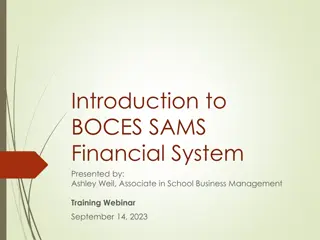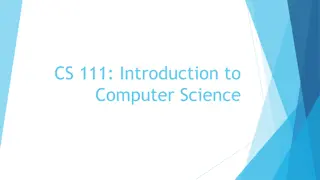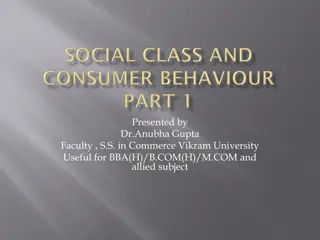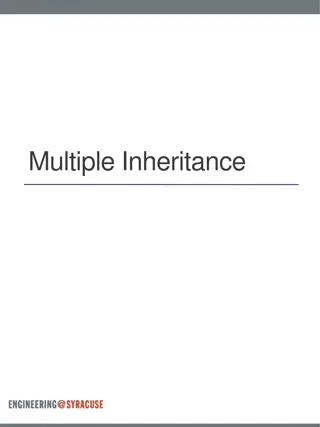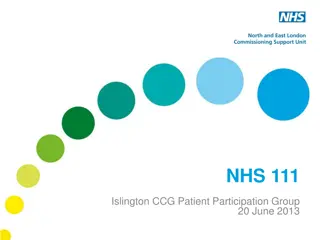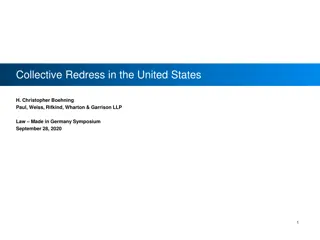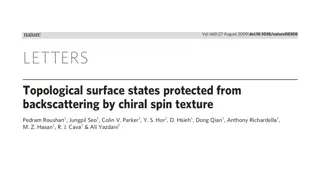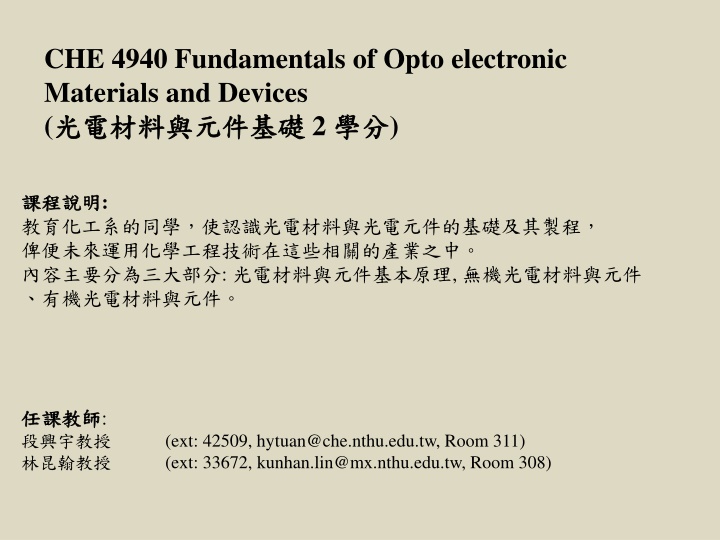
Opto-electronic Materials, Devices, and IC Manufacturing Overview
Explore the fundamentals of opto-electronic materials, devices, organic electronics, and integrated circuit manufacturing. Dive into topics like semiconductor fundamentals, solar cells, IC manufacturing processes, chemical vapor deposition, and more. Discover the advantages of using silicon in electronic applications.
Download Presentation

Please find below an Image/Link to download the presentation.
The content on the website is provided AS IS for your information and personal use only. It may not be sold, licensed, or shared on other websites without obtaining consent from the author. If you encounter any issues during the download, it is possible that the publisher has removed the file from their server.
You are allowed to download the files provided on this website for personal or commercial use, subject to the condition that they are used lawfully. All files are the property of their respective owners.
The content on the website is provided AS IS for your information and personal use only. It may not be sold, licensed, or shared on other websites without obtaining consent from the author.
E N D
Presentation Transcript
CHE 4940 Fundamentals of Opto electronic Materials and Devices ( 2 ) : : , : (ext: 42509, hytuan@che.nthu.edu.tw, Room 311) (ext: 33672, kunhan.lin@mx.nthu.edu.tw, Room 308)
I. : M7M8 M7M8 2/13 Class description 2/20 Semiconductor fundamentals Principle of optoelectronic devices(I) 3/6 3/13 Principle of optoelectronic devices (II) Principle of semiconductor-based solar cells 3/20 Integrated circuit (IC) manufacturing processes 3/27 Chemical vapor deposition (CVD) 4/10 4/17 Midterm
II Prof. M7M8 (course content) Introduction to organic electronics 4/24 Basic quantum chemistry 5/1 Optical and electronic properties 5/8 Structure-packing-properties relationship 5/15 Organic photovoltaics 5/22 Organic light-emitting diodes 5/29 6/5 Final exam
Part I. , 50%. Lectures (power point presentations) 1. PDF http://mx.nthu.edu.tw/~hytuan/ 2. , egg.4567@gmail.com
Integrated circuits (ICs) - Combination of transistors, diodes, capacitors in a chip - Ultra large scale integration (ULSI) >1,000,000 components per chips - Morre s law: the number of transistors on a chip were doubling every 18 months - Intel four core Itanium CPU- Tukwila has over 2 billion transistors on a chip Courtesy of wiki
Si, Si, Si, why Silicon??? Silicon has smallest carrier mobility compared with Ge and GaAs. Drawback of Ge -Ge s device easily to leak at high temp. -GeO2 is water soluble -melting point of Ge is only 937 C Drawback of GaAs -hard to get high quality and large size wafer -need additional procedures to form dielectic materials Advantage of Si -Cheap raw materials, e.g., rock, sand, second most abundant element on earth, appear as SiO2 - High melting point: 1415C - stable silicon oxide (SiO2) as dielectric materials
Optoelectronic devices using semiconductors: Si III-V I-III-VI, many semiconductors are candidates LED (light emitting diodes) Laser Solar cell Photodetector
The band gap of semiconductor optoelectronic materials corresponding to a optical spectrum E=1.24/ (eV) When E: electron volts : m E= hc/ -direct band gap materials -Compound (II-VI, III-V, IV-VI) semiconductors
LED basic manufacturing processes ,3-76 Similar manufacturing process could be also applied to laser, solar cell industry


